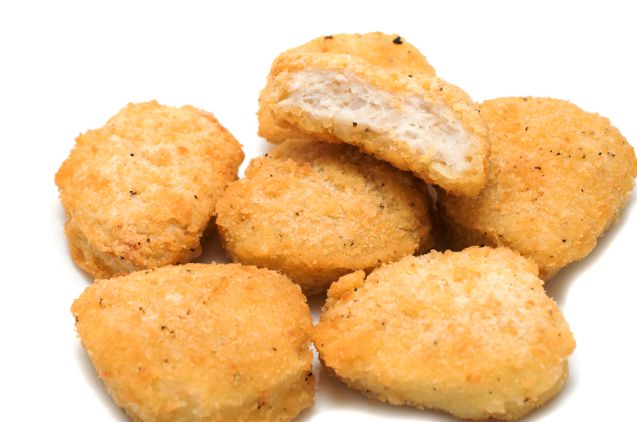How About a Little Bone and Nerves with your Chicken Nuggets
WEDNESDAY NOV 13, 2013 BY COLLEEN M. STORY

A recent study found chicken nuggets are less than 50 percent chicken.
If you want a glimpse of what fast food is really like, just let it cool down. I learned that when I was in college. Rushing from one class to the other, I sometimes grabbed something to eat from the nearby McDonald’s. One time, I ordered, parked my car outside the classroom, and had time to eat only half before I had to run inside or risk being late with a particularly stern professor. When I came back out an encountered the lard-like cold fries and hockey puck hamburger…ugh! Let’s just say I cured my fast food cravings right then.
There’s another way to determine what you’re really eating when you go through the drive through—send it to a lab. That’s what happened recently in Mississippi. Researchers decided to put chicken nuggets from two unnamed fast food chains under the microscope. What did they find?
“I was floored,” Dr. Richard deShazo stated. “I had read what other reports have said is in them and I didn’t believe it. I was astonished actually seeing it under the microscope.”
What the Study Found
To determine the composition of chicken nuggets, researchers gathered randomly selected ones from two different national food chains in Jackson, Mississippi. They then took one nugget from each box for a total of two, and preserved, sectioned and stained them for microscopic analysis.
Results showed:
The first nugget was about half muscle—the rest was a mix of fat, blood vessels and nerves
Closer inspection of the first one showed cells that line the skin of the internal organs
The second nugget was only 40 percent muscle—the rest was fat, cartilage, and pieces of bone
Overall, chicken meat was not the main component of either nugget—fat was present in equal or greater quantities, along with epithelium, bone, nerve, and connective tissue
What’s Going On?
According to the researchers, companies have chosen to use an artificial mixture of chicken parts to make the nuggets. Rather than actually frying up low-fat chicken, they’re using what is essentially a chicken by-product that’s high in calories, salt, sugar, and fat, and calling it real chicken.
“My concern is that these constitute a large part of people’s diets,” said deShazo. He acknowledged that the sample size in this study was particularly small, and that some chains have started to use primarily white meat in their nuggets—just not the ones they tested. But still, the worry is that people are eating them too often—particularly children.
“Even worse,” he said, “it tastes great and kids love it and it is marketed to them.”
Not the First Study
This wasn’t the first study to raise the “ick” factor of fast food chicken nuggets. Just a couple months ago, in August 2013, Mike Adams of Natural News reported on an investigation conducted by the Natural News Forensic Food Laboratory on McDonald’s Chicken McNuggets. Mike bought 10 pieces from a McDonald’s in Austin, Texas, and then examined them under a high-powered digital microscope.
“I’ve seen a lot of weird stuff in my decade of investigation foods and nutrition,” he wrote, “but I never expected to find this….”
Mike found strange fibers and dark black hair-like structures, as well as “light blue egg-shaped structures with attached tail-like hairs or fibers.” He didn’t identify these structures, but suggested the FDA take a closer look.
Back in 2010, Consumer Reports put chicken nuggets to the test and found most brands were loaded with salt and fat. After evaluating 14 supermarket brands of refrigerated and frozen ones, including two made from soy, they noted that choosing a healthier nugget would mean sacrificing flavor.
In 2012, a study published in the Canadian Medical Association Journal found that American fast-food customers get a larger dose of sodium when eating fast food items like chicken nuggets than do their counterparts in other countries—even for the exact same items. After analyzing nutrition information for more than 2,000 items sold by the world’s largest fast-food chains, they found fast food tended to be saltier in the U.S. than in Australia, Canada, France, New Zealand, and the U.K.
All this on top of the studies in 2012 that showed poultry on factory farms were often fed caffeine, active ingredients in Tylenol and Benadryl, banned antibiotics, and even arsenic.
The researchers in the Mississippi study didn’t go so far as to say you should avoid chicken nuggets. We’ll leave that up to you. If you’re on the fence, I say, just let them cool off a bit.
Labels: chicken nuggets, colon hydrotherapy philadelphia, colonic philadelphia, junk food, mcdonalds, nutrition







0 Comments :
Post a Comment
Subscribe to Post Comments [Atom]
<< Home